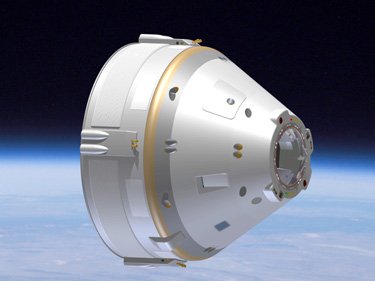
Illustration of Boeing's proposed CST-100 commercial crew capsule.
When Space Adventures announced last week a joint press conference with Boeing to discuss “a unique agreement between the two companies on commercial crew transportation services”, as the announcement put it, it seemed obvious what that agreement would involve: Space Adventures would sell seats on the CST-100, the commercial crew capsule that Boeing is developing to primarily serve other markets, such as transporting NASA crews to and from the International Space Station.
And that, in fact, was the announcement made yesterday. However, the nearly 90-minute press conference, held in a conference room at a Boeing office in Rosslyn, Virginia, across the Potomac from Washington, DC, provided plenty of opportunity for both companies to expound on the agreement and provide more details (or, in some cases, the lack of details). In short, Space Adventures will market “excess seating capacity” on CST-100 flights, primarily to the ISS, to potential spaceflight participants as soon as 2015.
Specific details about such flight, though, have yet to be worked out. John Elbon, vice president and program manager for commercial crew transportation systems at Boeing, said the notional model they were working from is taking advantage of any crew transportation flights NASA would procure as part of a future commercial crew program. The CST-100 is designed to accommodate up to seven people, but current NASA crew rotation models would require only four seats. The remaining capacity could be used for extra cargo, or for one or more spaceflight participants. He also didn’t rule out the possibility of dedicated flights, although this agreement between Boeing and Space Adventures does not include any flights to Bigelow Aerospace’s proposed commercial orbital facilities (Bigelow is a partner with Boeing on its current $18-million NASA Commercial Crew Development, or CCDev, award.)
Eric Anderson, chairman of Space Adventures (and who will remain involved with the company even though he took a job last week as president of Intentional Software, a company founded by two-time Space Adventures client Charles Simonyi) was vague about pricing for such seats, other than that they would be “competitive” with Soyuz pricing. Later, he noted that Space Adventures’ last Soyuz customer, Guy Laliberté, paid “around $40 million” for his trip.
Neither company would divulge how big they think the market is for such flights, but they were confident that there would be sufficient customers, even with a ticket price in the tens of millions. “We believe that we will be able to bring the spaceflight experience to a greater number of people than we would have before,” Anderson said. He added that “every flight opportunity that we have had the opportunity to sell, we have sold”, and thus the market was not constrained by the number of people who want to fly, but instead the number of flight opportunities.
Of course, this is all contingent on Boeing developing the CST-100, which the company said is, in turn, dependent on receiving NASA funding through a commercial crew program—a hot topic of debate across the Potomac from Boeing’s offices. “If we had to do this with Boeing investment only,” Elbon said, “we wouldn’t be able to close the business case.” NASA, he said, provides the program both development money as well as business transporting astronauts to and from the ISS. He said there are examples of past markets that got started with government investment, and Anderson noted aviation industry was supported by government airmail in its early years. “I think the argument that if it’s not purely funded and purely financed by private industry that there’s no market, I think that is, with all due respect, hogwash.”

[…] also has commercial partnerships with Bigelow Aerospace and Space Adventures, the latter involving selling seats on CST-100 flights to commercial customers, such as space […]